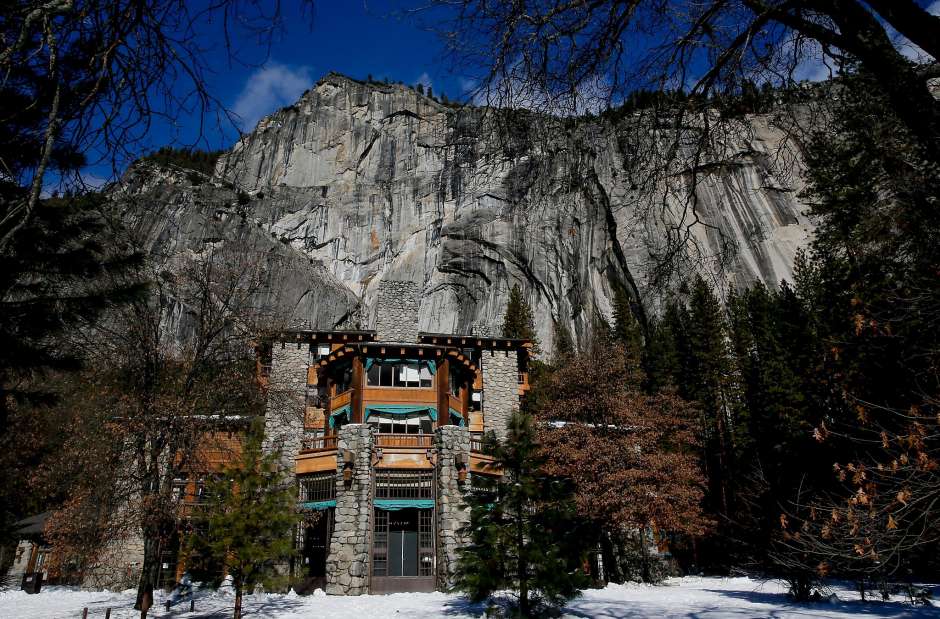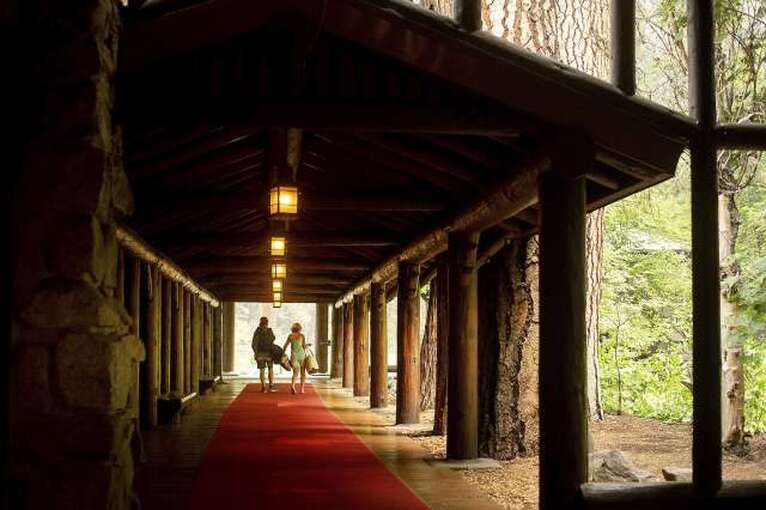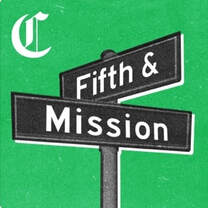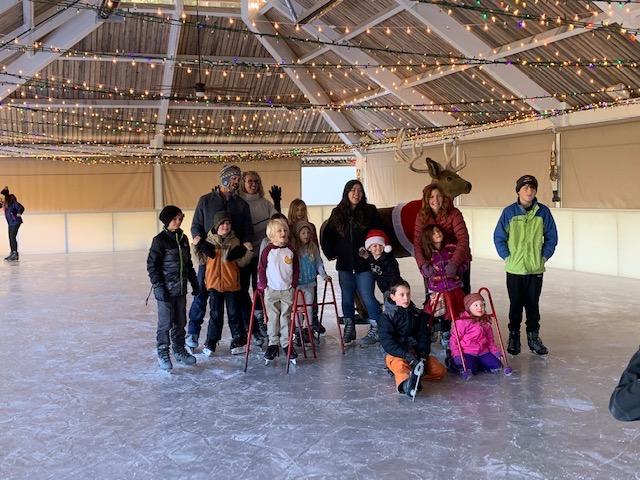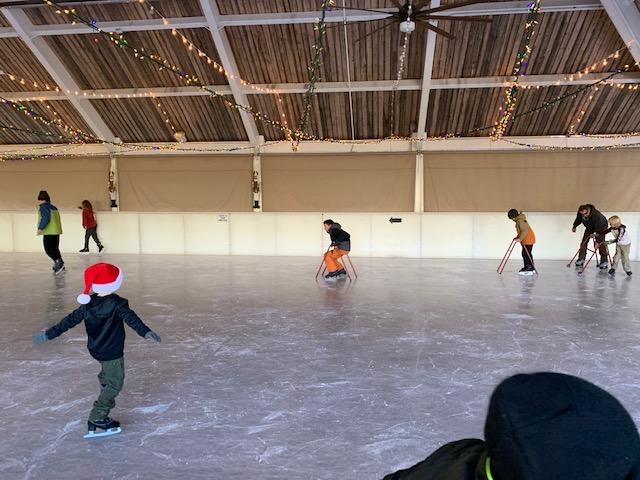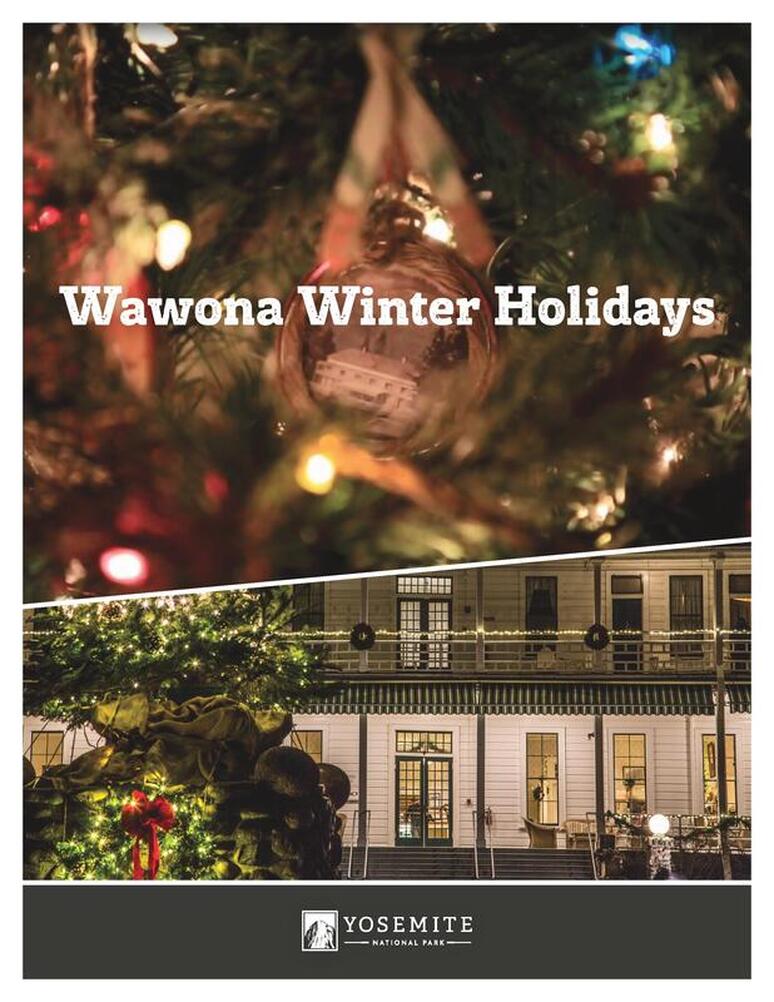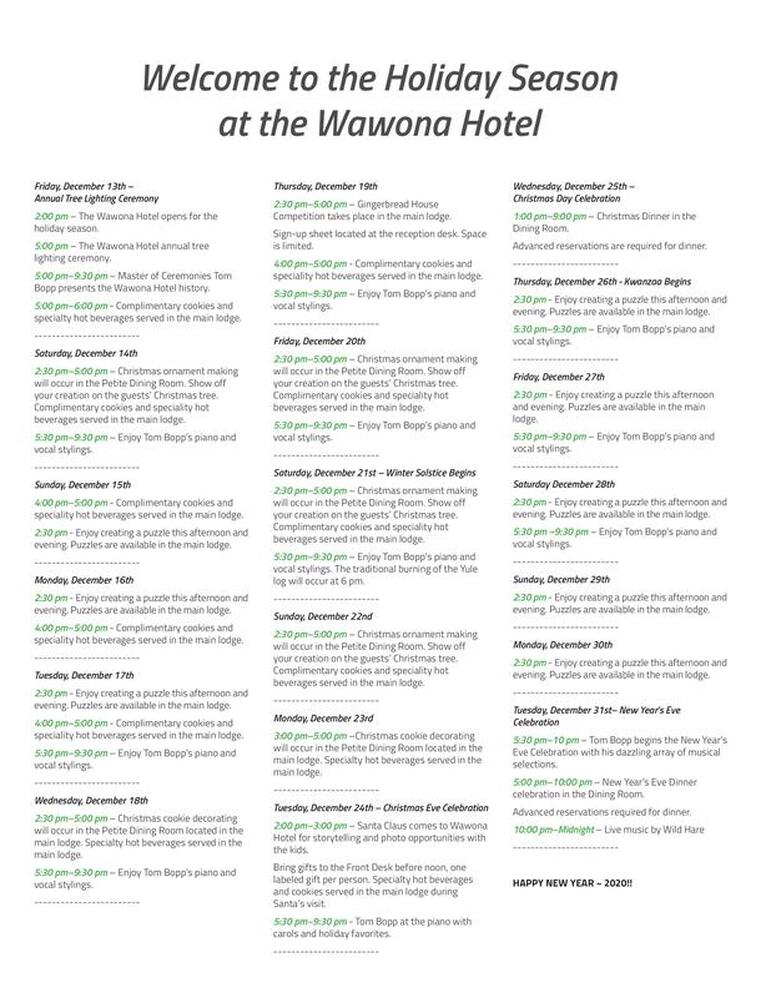WawonaNews.com - January 2020
Ahwahnee Hotel Loses Its Luster, Four-Diamond Award
Kurtis Alexander, San Francisco Chronicle, Jan. 7, 2020
Recent problems with visitor services at Yosemite National Park aren’t limited to overcrowded shuttle buses and deteriorating snack bars. They appear to have spread to the park’s luxury Ahwahnee Hotel.
Guests at the landmark property, where presidents and queens have wined, dined and snoozed at the foot of Half Dome, are reporting bad food, shabby rooms and indifferent staff. Hotel inspectors with AAA, meanwhile, have revoked the Ahwahnee’s prestigious four-diamond rating, a distinction the site had held since 1991.
“When you say the Ahwahnee is being downgraded or it’s not up to snuff, it’s a big deal,” said Al Runte, an environmental historian who has written extensively about Yosemite. “This is one of the iconic masterpieces of the national parks.”
The hotel’s apparent slide follows rising frustration with services throughout Yosemite, starting after Philadelphia-based Aramark won the contract to manage the park’s concessions nearly four years ago.
The hospitality giant initially invested millions of dollars in the many restaurants, shops and hotels under its wing. But a spike in visitor complaints, which began with long waits for shuttle buses that saw vacationers fighting to board the coaches, documented last year by The Chronicle, soon followed.
The latest issues at the Ahwahnee seem — at first blush — rather petty. One guest who has stayed there a half-dozen times said the onion soup she ordered in the dining room was nothing but an oily block of cheese. Another guest pointed to outbuildings that appeared a bit run down, while another said hotel staff were slow to respond to requests.
But the critiques add up, and with nightly rates ranging from about $400 to more than $1,000, high expectations are understandable.
“This may not be a big deal in some people’s minds,” said Elizabeth Powell, 77, a Berkeley resident and hotel guest who recently found wasps in her room that had apparently flown in through a hole in the balcony’s screen door. She also cited shoddy spackling work and cheap pillows. “But it was $690 a night.”
“I usually don’t get caught up with things like this, but it’s such a wonderful place,” Powell added. “If they’re going to dumb it down like they’re doing, it’s just terrible.”
Recent problems with visitor services at Yosemite National Park aren’t limited to overcrowded shuttle buses and deteriorating snack bars. They appear to have spread to the park’s luxury Ahwahnee Hotel.
Guests at the landmark property, where presidents and queens have wined, dined and snoozed at the foot of Half Dome, are reporting bad food, shabby rooms and indifferent staff. Hotel inspectors with AAA, meanwhile, have revoked the Ahwahnee’s prestigious four-diamond rating, a distinction the site had held since 1991.
“When you say the Ahwahnee is being downgraded or it’s not up to snuff, it’s a big deal,” said Al Runte, an environmental historian who has written extensively about Yosemite. “This is one of the iconic masterpieces of the national parks.”
The hotel’s apparent slide follows rising frustration with services throughout Yosemite, starting after Philadelphia-based Aramark won the contract to manage the park’s concessions nearly four years ago.
The hospitality giant initially invested millions of dollars in the many restaurants, shops and hotels under its wing. But a spike in visitor complaints, which began with long waits for shuttle buses that saw vacationers fighting to board the coaches, documented last year by The Chronicle, soon followed.
The latest issues at the Ahwahnee seem — at first blush — rather petty. One guest who has stayed there a half-dozen times said the onion soup she ordered in the dining room was nothing but an oily block of cheese. Another guest pointed to outbuildings that appeared a bit run down, while another said hotel staff were slow to respond to requests.
But the critiques add up, and with nightly rates ranging from about $400 to more than $1,000, high expectations are understandable.
“This may not be a big deal in some people’s minds,” said Elizabeth Powell, 77, a Berkeley resident and hotel guest who recently found wasps in her room that had apparently flown in through a hole in the balcony’s screen door. She also cited shoddy spackling work and cheap pillows. “But it was $690 a night.”
“I usually don’t get caught up with things like this, but it’s such a wonderful place,” Powell added. “If they’re going to dumb it down like they’re doing, it’s just terrible.”
The Ahwahnee Hotel, designed by noted architect Gilbert Stanley Underwood, opened in 1927 as an upscale lodge intended to showcase the best of the National Park Service. With its giant wood-beamed dining room, huge fireplaces in its Grand Lounge and grass lawn beneath the towering cliffs of Yosemite Valley, the property has attracted several presidents, including John F. Kennedy and Barack Obama, as well as Queen Elizabeth II.
A spokesman for Aramark denied that conditions and service at the Ahwahnee have lagged. Guest feedback to hotel staff has been overwhelmingly positive, said David Freireich, Aramark’s senior director of corporate communications.
“We’ve heard that our visitors continue to be awed and inspired,” he said.
Indeed, popular travel websites such as Trip Advisor and Expedia show that reviews of the Ahwahnee still average at least four out of five stars. One recent guest wrote on Google: “The Ahwahnee is well thought out and special ... And you are in the most spectacular natural environment imaginable. What’s not to love?”
Freireich dismissed the downgrade from AAA as a reflection of that organization’s rising standards, not the quality of the hotel. Some of the scoring involves having technology, such as faster internet, which can be tough to deliver in a remote location, while amenities that have become increasingly common, such as spas and big swimming pools, may not be appropriate in a national park.
“Our historic status prevents us from making certain changes that would be needed to raise our scores,” Freireich said.
AAA, as a matter of policy, did not specify why the Ahwahnee’s rating had slid from four diamonds to three diamonds.
The nonprofit organization, the longtime standard-bearer of hotel reviews, employs full-time inspectors to evaluate properties. The hotels that meet its standards are graded on a scale of one to five diamonds. The four-diamond rating, which conveys a sense of elegance and prestige, is awarded to just 6% of its approved sites, just one notch shy of the best-in-the-world five-diamond grade.
A spokesman for Aramark denied that conditions and service at the Ahwahnee have lagged. Guest feedback to hotel staff has been overwhelmingly positive, said David Freireich, Aramark’s senior director of corporate communications.
“We’ve heard that our visitors continue to be awed and inspired,” he said.
Indeed, popular travel websites such as Trip Advisor and Expedia show that reviews of the Ahwahnee still average at least four out of five stars. One recent guest wrote on Google: “The Ahwahnee is well thought out and special ... And you are in the most spectacular natural environment imaginable. What’s not to love?”
Freireich dismissed the downgrade from AAA as a reflection of that organization’s rising standards, not the quality of the hotel. Some of the scoring involves having technology, such as faster internet, which can be tough to deliver in a remote location, while amenities that have become increasingly common, such as spas and big swimming pools, may not be appropriate in a national park.
“Our historic status prevents us from making certain changes that would be needed to raise our scores,” Freireich said.
AAA, as a matter of policy, did not specify why the Ahwahnee’s rating had slid from four diamonds to three diamonds.
The nonprofit organization, the longtime standard-bearer of hotel reviews, employs full-time inspectors to evaluate properties. The hotels that meet its standards are graded on a scale of one to five diamonds. The four-diamond rating, which conveys a sense of elegance and prestige, is awarded to just 6% of its approved sites, just one notch shy of the best-in-the-world five-diamond grade.
Spokeswoman Julie Hall said the Ahwahnee simply didn’t meet the bar for four diamonds when inspectors visited the hotel in 2018 for the 2019 score.
The Ahwahnee’s home page, however, continued to boast of its four-diamond award until last month, when The Chronicle inquired about the rating. A plaque behind the hotel’s front desk still advertised the four-diamond review as of last weekend.
Officials with the National Park Service confirmed that complaints about the Ahwahnee have been on the rise.
Yosemite spokesman Scott Gediman noted comments about disappointing food quality, dirty rooms and poor treatment from hotel employees and said the observations were among increasing criticism in recent years about services parkwide.
“We take this very seriously,” Gediman said. “We have been meeting with Aramark to discuss the complaints and remediation.”
Last year, the park service gave Aramark a failing grade in its annual performance review for operations at Yosemite, knocking it for problems with shuttles, dining halls and campground reservations. As a sanction, park officials threatened to deny the company’s request to raise rates for service. Aramark needs park permission to charge higher prices, which help cover increasing costs and maintain profitability. The park service has yet to act on the threat.
Aramark’s contract in Yosemite is one of the most lucrative in the park service, estimated to be worth $140 million annually. The company took over services for former concessionaire Delaware North, which lost the contract after operating in the park for decades. Aramark’s contract runs through 2031.
Jane Lundin, 87, of Richmond, whose grandson drove her and her new husband to the Ahwahnee for their honeymoon, said the stay didn’t come close to matching her previous visits to the hotel.
“It’s still a beautiful building. The place is wonderful,” Lundin said. “But I remember eating the world’s worst food. ... An awful fish with peppery fava beans, and cold coffee.”
The Ahwahnee’s home page, however, continued to boast of its four-diamond award until last month, when The Chronicle inquired about the rating. A plaque behind the hotel’s front desk still advertised the four-diamond review as of last weekend.
Officials with the National Park Service confirmed that complaints about the Ahwahnee have been on the rise.
Yosemite spokesman Scott Gediman noted comments about disappointing food quality, dirty rooms and poor treatment from hotel employees and said the observations were among increasing criticism in recent years about services parkwide.
“We take this very seriously,” Gediman said. “We have been meeting with Aramark to discuss the complaints and remediation.”
Last year, the park service gave Aramark a failing grade in its annual performance review for operations at Yosemite, knocking it for problems with shuttles, dining halls and campground reservations. As a sanction, park officials threatened to deny the company’s request to raise rates for service. Aramark needs park permission to charge higher prices, which help cover increasing costs and maintain profitability. The park service has yet to act on the threat.
Aramark’s contract in Yosemite is one of the most lucrative in the park service, estimated to be worth $140 million annually. The company took over services for former concessionaire Delaware North, which lost the contract after operating in the park for decades. Aramark’s contract runs through 2031.
Jane Lundin, 87, of Richmond, whose grandson drove her and her new husband to the Ahwahnee for their honeymoon, said the stay didn’t come close to matching her previous visits to the hotel.
“It’s still a beautiful building. The place is wonderful,” Lundin said. “But I remember eating the world’s worst food. ... An awful fish with peppery fava beans, and cold coffee.”
Trouble at Yosemite's Iconic Hotel
|
For decades, the sumptuous Ahwahnee Hotel at the foot of Half Dome has attracted presidents, movie stars and big spenders. But as Kurtis Alexander reports, some say the property has seen better days.
Click here to listen to Fifth & Mission podcast. |
Wawona School Students Go Ice Skating
Wawona students enjoyed a morning of ice skating at Tenaya Lodge with teacher Stacy Boydstun. And where have we seen that funny-looking deer before?
Bingo on Monday, December 16th at 6:30 PM
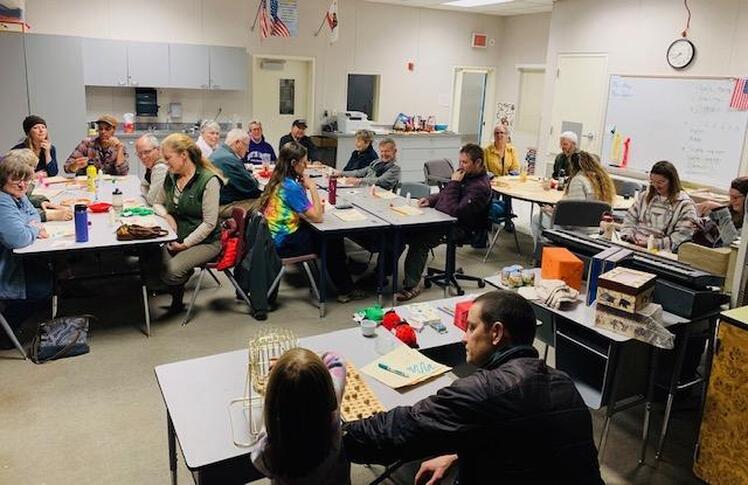
Join us Monday evening, December 16th. BINGO games will start at 6:30. There will also be a cookie/dessert exchange so bring a dozen goodies and go home with a different dozen!! 10 Dimes for Jackpots.
Photos From The 2019 Christmas Tree Lighting and Larry Duke's 80th Birthday Celebration
First Snowshoe Walk of The Season to Dewey Point
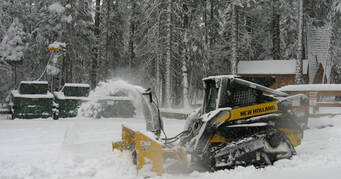
Looking for Snow Removal Operator
MAINTENANCE WORKER I/II – SNOW REMOVAL WAWONA AREA (EXTRA HELP ONLY*) $18.35 - $24.40/hour Application Deadline: OPEN UNTIL FILLED
Apply Online: www.mariposacounty.org
*Extra-Help (part-time) = An extra-help assignment is part-time employment limited to a set number of hours per fiscal year; no benefits accompany this category. For assistance or questions, please contact Human Resources at 209/742-1379 P.O. Box 1917 (4988 11th Street, Suite B), Mariposa, CA 95338 EOE
MAINTENANCE WORKER I/II – SNOW REMOVAL WAWONA AREA (EXTRA HELP ONLY*) $18.35 - $24.40/hour Application Deadline: OPEN UNTIL FILLED
Apply Online: www.mariposacounty.org
*Extra-Help (part-time) = An extra-help assignment is part-time employment limited to a set number of hours per fiscal year; no benefits accompany this category. For assistance or questions, please contact Human Resources at 209/742-1379 P.O. Box 1917 (4988 11th Street, Suite B), Mariposa, CA 95338 EOE

Badger Pass Ski Area Information
Ski, Snowboard & Tube - It's All Right Here
Scheduled Operating Season for 2019-20
Please call the Snow Phone at 209.372.1000 for conditions, weather and ski area information.
Ski, Snowboard & Tube - It's All Right Here
Scheduled Operating Season for 2019-20
- December 13, 2019 - March 29, 2020 (conditions permitting)
Please call the Snow Phone at 209.372.1000 for conditions, weather and ski area information.
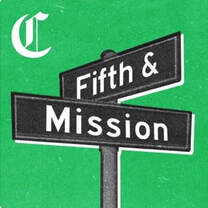
YOSEMITE-WAWONA ELEMENTARY CHARTER SCHOOL
Board of Directors Regular Meeting
Tuesday, December 10, 2019
5:30 P.M.
Wawona Elementary School
7925 Chilnualana Falls Road
Wawona, CA
MONTHLY ITEMS AND FINANCIAL REPORTS
3.1- Approval of Agenda
3.2– Approval of Minutes of the regular meeting of Nov. 12, 2019 and the Special Meeting/ Board Workshop on Nov. 20.
3.3 - Approve Warrants
3.4 – Declare 4 bus tires as surplus (and donate to the fire department)
3.5 – Accept Donations to YWECS
WAPPOA
Denise Mee
Ed Mee
Bruce and Natali Monroe
Teresa and Eric Stiegler
John and Katharine Broesamile
Paul and Kathleen Desantis
V and Gabrielle Luo
Darla Miller
ACTION ITEMS
INFORMATION ITEMS
Board of Directors Regular Meeting
Tuesday, December 10, 2019
5:30 P.M.
Wawona Elementary School
7925 Chilnualana Falls Road
Wawona, CA
- CALL TO ORDER
- ROLL CALL
MONTHLY ITEMS AND FINANCIAL REPORTS
- CONSENT AGENDA
3.1- Approval of Agenda
3.2– Approval of Minutes of the regular meeting of Nov. 12, 2019 and the Special Meeting/ Board Workshop on Nov. 20.
3.3 - Approve Warrants
3.4 – Declare 4 bus tires as surplus (and donate to the fire department)
3.5 – Accept Donations to YWECS
WAPPOA
Denise Mee
Ed Mee
Bruce and Natali Monroe
Teresa and Eric Stiegler
John and Katharine Broesamile
Paul and Kathleen Desantis
V and Gabrielle Luo
Darla Miller
- HEARING OF PERSONS WISHING TO ADDRESS THE BOARD
ACTION ITEMS
- APPROVE THE FIRST INTERIM FINANCIAL REPORT FOR YWECS.
- TAKE POSSIBLE BOARD ACTION TO REQUEST THAT THE PARK SERVICE DISCONTINUE THE CHARGING OF YWECS FOR BOTH SEWER AND WATER SERVICES AND PROVIDE ADDITIONAL BUILDING MAINTENANCE.
- CONSIDER A BID TO UPDATE AND/OR RECONSTRUCT THE CHARTER’S WEBSITE.
- COMMITMENT TO THE BOARD GOVERNANCE AGREEMENT
INFORMATION ITEMS
- REPORT ON THE STATUS OF THE SCHOOL BUS LEASE
- STAFF REPORTS
- BOARD MEMBER COMMENTS
- FUTURE AGENDA ITEMS
- NEXT BOARD MEETING
- CLOSED SESSION: Personnel/Negotiations/Litigation
- Personnel (Gov. Code 54957)
- RECONVENE IN OPEN SESSION: Announce Closed Session Actions
- ADJOURNMENT
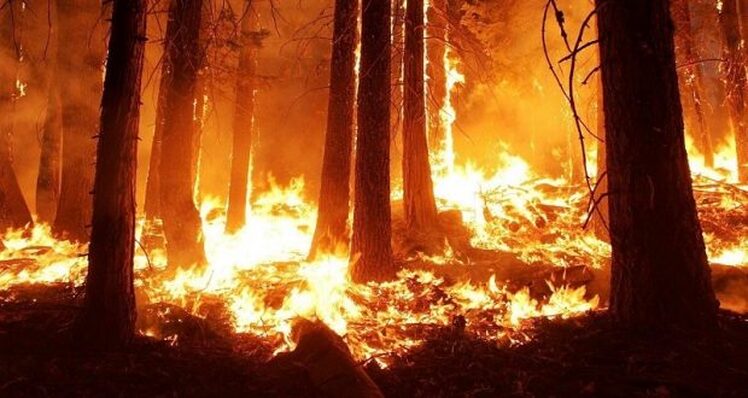
Wildfire Insurance Crisis Leads to Call for First-ever State Non-Renewal Moratorium
Posted by: SNO Staff December 5, 2019
OAKLAND — California’s Insurance Commissioner Ricardo Lara on Thursday issued a mandatory one-year moratorium on insurance companies non-renewing policyholders — helping at least 800,000 homeowners in wildfire disaster areas across the state.
The commissioner’s action is the result of Senate Bill 824 — authored last year by Lara while serving as state senator — in order to give temporary relief from non-renewals to residents living near a declared wildfire disaster.
This is the first time the department has invoked the new law, which took effect in January.
Because the homeowner insurance crisis extends beyond the wildfire perimeters and impacts residents statewide, Commissioner Lara went a step further and called on insurance companies to voluntarily cease all non-renewals related to wildfire risk statewide until December 5, 2020, in the wake of Governor Gavin Newsom’s declaration of statewide emergency due to fires and extreme weather conditions.
A statewide moratorium would provide all California homeowners, renters and businesses peace of mind, and allow time for stakeholders to come together to work on lasting solutions, help reduce wildfire risk, and stabilize the insurance market.
“This wildfire insurance crisis has been years in the making, but it is an emergency we must deal with now if we are going to keep the California dream of home ownership from becoming the California nightmare, as an increasing number of homeowners struggle to find coverage,” said Lara.
“I am calling on insurance companies to push the pause button on issuing non-renewals for one year to give breathing room to communities and homeowners while they adapt and mitigate risks, give the Legislature time to work on additional lasting solutions, and allow California’s insurance market to stabilize.”
Lara announced the action at a home in Oakland alongside local leaders from affected areas and consumer advocates, following months of meetings across the state with county officials, community leaders, and more than 2,000 homeowners who have been non-renewed and struggled to find new coverage.
“As communities across California continue to recover from wildfires and natural disasters, insurance companies are critical partners in helping our communities rise up,” said Sonoma County Supervisor James Gore, who serves as second vice president of the California State Association of Counties. “The inability to obtain insurance after disaster strikes impacts home values and tax revenues for emergency services that help ensure the integrity of California communities. On behalf of Sonoma County and every county statewide navigating the rebuilding and recovery process, we call on our insurance partners to help us move toward a more resilient future.”
The mandatory one-year moratorium covers more than 800,000 residential policies in ZIP Codes adjacent to recent wildfire disasters under the newly enacted Senate Bill 824, also known as the Wildfire Safety and Recovery Act.
While existing law prevents non-renewals for those who suffer a total loss, the new law established protection for those living adjacent to a declared wildfire emergency who did not suffer a total loss — recognizing for the first time in law the disruption that non-renewals cause in communities following wildfire disasters.
“Home insurance is not a luxury – it’s a necessity. Yet for hundreds of thousands of Californians it’s become almost impossible to find and afford. This puts people between a rock and a hard place, and communities up and down the state are hurting,” said Amy Bach, executive director of United Policyholders. “At United Policyholders we are doing all we can to help consumers deal with this situation and we thank Commissioner Lara for authoring the moratorium bill and agreeing to take further action with a statewide voluntary moratorium.”
Following Governor Newsom’s emergency declarations in October, the Department of Insurance partnered with CAL FIRE and the Governor’s Office of Emergency Services to identify wildfire perimeters and adjacent ZIP codes within the mandatory moratorium area.
Today’s bulletin includes seven of the 16 wildfires within state-declared emergency areas, and CAL-FIRE is working to identify perimeters for the remaining nine fires, which the Department of Insurance will announce in a separate bulletin.
Commissioner Lara’s action comes amid growing evidence that homeowner insurance has become more difficult for Californians to obtain from traditional markets, forcing them into more expensive, less comprehensive options such as the FAIR Plan that do not offer the same level of coverage or protections.
In August, the Department of Insurance released data revealing insurance companies are dropping an increasing number of residents in areas with high wildfire risk. The number of non-renewals rose by more than 10 percent last year in seven counties from San Diego to Sierra—a direct response to California’s recent devastating wildfires. The number of consumers covered by the FAIR Plan—California’s insurer of last resort —has surged in areas with high wildfire risk.
According to the U.S. Forest Service, more than 3.6 million California households are located in the wildland urban interface where wildfires are most likely to occur.
Today’s action builds on Commissioner Lara’s order last month to modernize the FAIR Plan and strengthens California’s insurance safety net.
No later than June 1, 2020, the FAIR Plan will expand its coverage to offer a full homeowners policy in addition to its current limited fire-only policy.
By April 1, 2020, the FAIR Plan will increase the Dwelling Fire combined policy limit from $1.5 million to $3 million, in recognition of higher home values. By February 1, 2020, the FAIR Plan will offer a monthly payment plan without fees and allow people to pay by credit card or electronic funds transfer without fees.
For more information, go to http://www.insurance.ca.gov/0400-news/0100-press-releases/2019/wildfirenonrenewalinfo.cfm
Posted by: SNO Staff December 5, 2019
OAKLAND — California’s Insurance Commissioner Ricardo Lara on Thursday issued a mandatory one-year moratorium on insurance companies non-renewing policyholders — helping at least 800,000 homeowners in wildfire disaster areas across the state.
The commissioner’s action is the result of Senate Bill 824 — authored last year by Lara while serving as state senator — in order to give temporary relief from non-renewals to residents living near a declared wildfire disaster.
This is the first time the department has invoked the new law, which took effect in January.
Because the homeowner insurance crisis extends beyond the wildfire perimeters and impacts residents statewide, Commissioner Lara went a step further and called on insurance companies to voluntarily cease all non-renewals related to wildfire risk statewide until December 5, 2020, in the wake of Governor Gavin Newsom’s declaration of statewide emergency due to fires and extreme weather conditions.
A statewide moratorium would provide all California homeowners, renters and businesses peace of mind, and allow time for stakeholders to come together to work on lasting solutions, help reduce wildfire risk, and stabilize the insurance market.
“This wildfire insurance crisis has been years in the making, but it is an emergency we must deal with now if we are going to keep the California dream of home ownership from becoming the California nightmare, as an increasing number of homeowners struggle to find coverage,” said Lara.
“I am calling on insurance companies to push the pause button on issuing non-renewals for one year to give breathing room to communities and homeowners while they adapt and mitigate risks, give the Legislature time to work on additional lasting solutions, and allow California’s insurance market to stabilize.”
Lara announced the action at a home in Oakland alongside local leaders from affected areas and consumer advocates, following months of meetings across the state with county officials, community leaders, and more than 2,000 homeowners who have been non-renewed and struggled to find new coverage.
“As communities across California continue to recover from wildfires and natural disasters, insurance companies are critical partners in helping our communities rise up,” said Sonoma County Supervisor James Gore, who serves as second vice president of the California State Association of Counties. “The inability to obtain insurance after disaster strikes impacts home values and tax revenues for emergency services that help ensure the integrity of California communities. On behalf of Sonoma County and every county statewide navigating the rebuilding and recovery process, we call on our insurance partners to help us move toward a more resilient future.”
The mandatory one-year moratorium covers more than 800,000 residential policies in ZIP Codes adjacent to recent wildfire disasters under the newly enacted Senate Bill 824, also known as the Wildfire Safety and Recovery Act.
While existing law prevents non-renewals for those who suffer a total loss, the new law established protection for those living adjacent to a declared wildfire emergency who did not suffer a total loss — recognizing for the first time in law the disruption that non-renewals cause in communities following wildfire disasters.
“Home insurance is not a luxury – it’s a necessity. Yet for hundreds of thousands of Californians it’s become almost impossible to find and afford. This puts people between a rock and a hard place, and communities up and down the state are hurting,” said Amy Bach, executive director of United Policyholders. “At United Policyholders we are doing all we can to help consumers deal with this situation and we thank Commissioner Lara for authoring the moratorium bill and agreeing to take further action with a statewide voluntary moratorium.”
Following Governor Newsom’s emergency declarations in October, the Department of Insurance partnered with CAL FIRE and the Governor’s Office of Emergency Services to identify wildfire perimeters and adjacent ZIP codes within the mandatory moratorium area.
Today’s bulletin includes seven of the 16 wildfires within state-declared emergency areas, and CAL-FIRE is working to identify perimeters for the remaining nine fires, which the Department of Insurance will announce in a separate bulletin.
Commissioner Lara’s action comes amid growing evidence that homeowner insurance has become more difficult for Californians to obtain from traditional markets, forcing them into more expensive, less comprehensive options such as the FAIR Plan that do not offer the same level of coverage or protections.
In August, the Department of Insurance released data revealing insurance companies are dropping an increasing number of residents in areas with high wildfire risk. The number of non-renewals rose by more than 10 percent last year in seven counties from San Diego to Sierra—a direct response to California’s recent devastating wildfires. The number of consumers covered by the FAIR Plan—California’s insurer of last resort —has surged in areas with high wildfire risk.
According to the U.S. Forest Service, more than 3.6 million California households are located in the wildland urban interface where wildfires are most likely to occur.
Today’s action builds on Commissioner Lara’s order last month to modernize the FAIR Plan and strengthens California’s insurance safety net.
No later than June 1, 2020, the FAIR Plan will expand its coverage to offer a full homeowners policy in addition to its current limited fire-only policy.
By April 1, 2020, the FAIR Plan will increase the Dwelling Fire combined policy limit from $1.5 million to $3 million, in recognition of higher home values. By February 1, 2020, the FAIR Plan will offer a monthly payment plan without fees and allow people to pay by credit card or electronic funds transfer without fees.
For more information, go to http://www.insurance.ca.gov/0400-news/0100-press-releases/2019/wildfirenonrenewalinfo.cfm
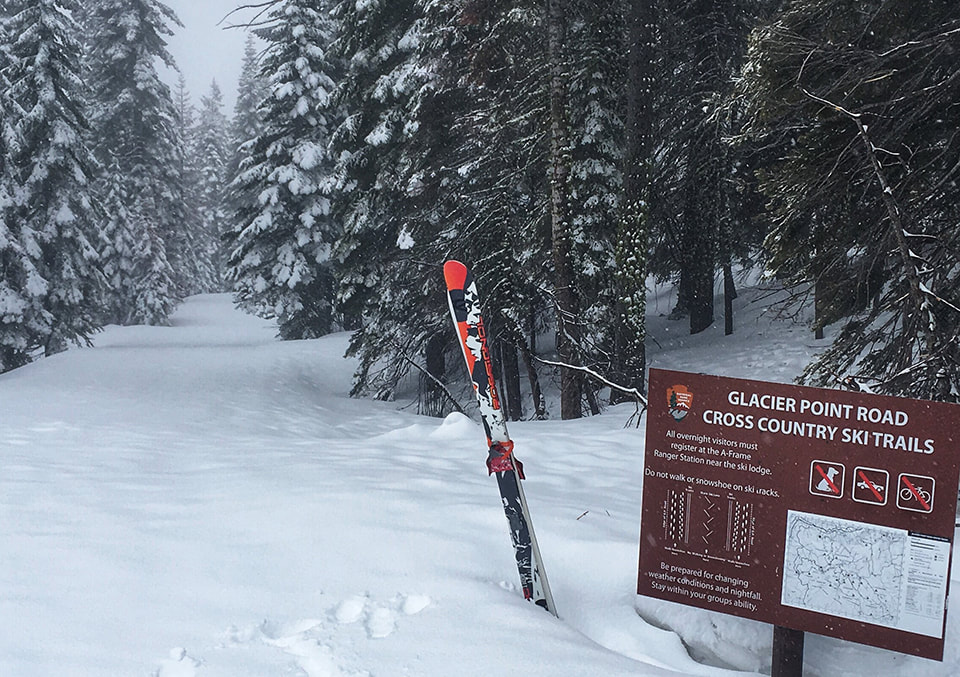
Glacier Point, Tioga Roads Close for Season
Posted by: SNO Staff November 27, 2019 - 9:13 am
YOSEMITE NATIONAL PARK — Yosemite National Park officials announced Wednesday that Glacier Point and Tioga Roads are now closed to all vehicular traffic for the winter season.
Glacier Point and Tioga Roads typically close each fall and remain closed through the winter season, reopening in spring when weather and road conditions are safe for vehicular traffic.
“Yosemite National Park is anticipating a busy Thanksgiving holiday weekend from Wednesday, November 27 through Sunday, December 1, 2019,” stated a release issued Wednesday by park officials. “Visitors planning to come to the park for day trips or to stay overnight are encouraged to be prepared for winter driving, hiking and camping conditions. Yosemite National Park is expecting impacts throughout the park from incoming winter storms.”
Yosemite National Park is open year-round with snow removal on all other roads within the park.
All motorists are required to carry tire chains in their vehicles while driving in the park during the winter months, even if their car is equipped with four-wheel drive.
Temporary road closures may go into effect at any time due to road and weather conditions.
For updated 24-hour road and weather conditions for Yosemite National Park, please call 209-372-0200, press 1 and press 1 again. Updated information is also available on the park’s website at www.nps.gov/yose.
For information on public transportation to Yosemite National Park and current bus schedules, please visit the website for the Yosemite Area Regional Transportation System (YARTS) at www.yarts.com.
Posted by: SNO Staff November 27, 2019 - 9:13 am
YOSEMITE NATIONAL PARK — Yosemite National Park officials announced Wednesday that Glacier Point and Tioga Roads are now closed to all vehicular traffic for the winter season.
Glacier Point and Tioga Roads typically close each fall and remain closed through the winter season, reopening in spring when weather and road conditions are safe for vehicular traffic.
“Yosemite National Park is anticipating a busy Thanksgiving holiday weekend from Wednesday, November 27 through Sunday, December 1, 2019,” stated a release issued Wednesday by park officials. “Visitors planning to come to the park for day trips or to stay overnight are encouraged to be prepared for winter driving, hiking and camping conditions. Yosemite National Park is expecting impacts throughout the park from incoming winter storms.”
Yosemite National Park is open year-round with snow removal on all other roads within the park.
All motorists are required to carry tire chains in their vehicles while driving in the park during the winter months, even if their car is equipped with four-wheel drive.
Temporary road closures may go into effect at any time due to road and weather conditions.
For updated 24-hour road and weather conditions for Yosemite National Park, please call 209-372-0200, press 1 and press 1 again. Updated information is also available on the park’s website at www.nps.gov/yose.
For information on public transportation to Yosemite National Park and current bus schedules, please visit the website for the Yosemite Area Regional Transportation System (YARTS) at www.yarts.com.
